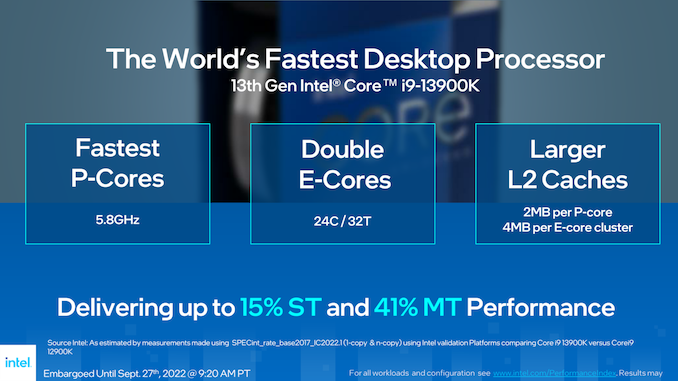Raptor Lake Brings More Bite
Today marks the release of Intel’s 13th generation Core processor series, codenamed Raptor Lake. The first models to be unleashed into retail channels are all overclockable parts, with six SKUs across the Core i9, i7, and i5 product segments. We’ve seen Intel’s heterogeneous or hybrid design with the launch of Intel’s Alder Lake (12th Gen Core) products, and the latest Raptor Lake core brings a very similar design to the table, but with subtle improvements designed to help give Intel the leading edge in the desktop market.
The launch of Intel’s new lineup is essentially the second half of this fall’s desktop CPU releases. AMD got the first word in a few weeks back with the launch of their Ryzen 7000 desktop processors, which introduced the Zen 4 architecture as well a significant platform update for AMD with Socket AM5. The new high-end Ryzen chips were well-received (if a bit expensive), setting a new bar for performance and putting AMD firmly into the lead, at least for a little bit. Now it’s time for Intel’s own CPU launch – their rebuttal – where they get to show off what they’ve been working on over the past few years and whether they can retain their edge over AMD for this latest generation of processors.
At a high level, Raptor Lake can be thought of as a mid-cycle upgrade of sorts for Intel’s current LGA-1700 platform. As the company launched Alder Lake and LGA-1700 just a year ago, they aren’t looking to overhaul the core CPU architecture quite so soon, nor the platform for that matter. Intel is keeping to their two-year platform cycle here, so the 13th generation of Core processors are designed to bring more performance to the same platform as Alder Lake. This makes the Raptor Lake launch significantly more straightforward than AMD’s recent launch, where AMD overhauled their entire platform while also making some more significant CPU architecture upgrades in the process.
Because Intel isn’t significantly tweaking their CPU architectures for Raptor Lake, the chip is essentially a refined version of Alder Lake. That means we’re still looking at a mixture of P(erformance) and E(fficiency) CPU cores, based on different CPU architectures and designed to allow Intel to hit high performance levels in both single/light-threaded workloads that favor the P cores, and heavily multi-threaded workloads that can also saturate the E cores. The P cores are based on what’s technically a new architecture, Raptor Cove, while the E cores are still based on the same Gracemont architecture as what we saw on Alder Lake.
We’ll dive into the internal bits of Raptor Lake a bit later on, but at a high level, Intel is improving performance versus Alder Lake in three ways.
- Higher clockspeeds, especially for the P cores, thanks to some architectural optimization work combined with further refinements of the Intel 7 fab process
- Additional E cores in all desktop SKUs, to boost performance in multi-threaded workloads
- Additional L2 cache for both the P and E cores. The L3 cache is also a bit larger, primarily to accommodate the larger number of E cores.
The higher clockspeeds and additional cache mean that…
Read More: Raptor Lake Brings More Bite

